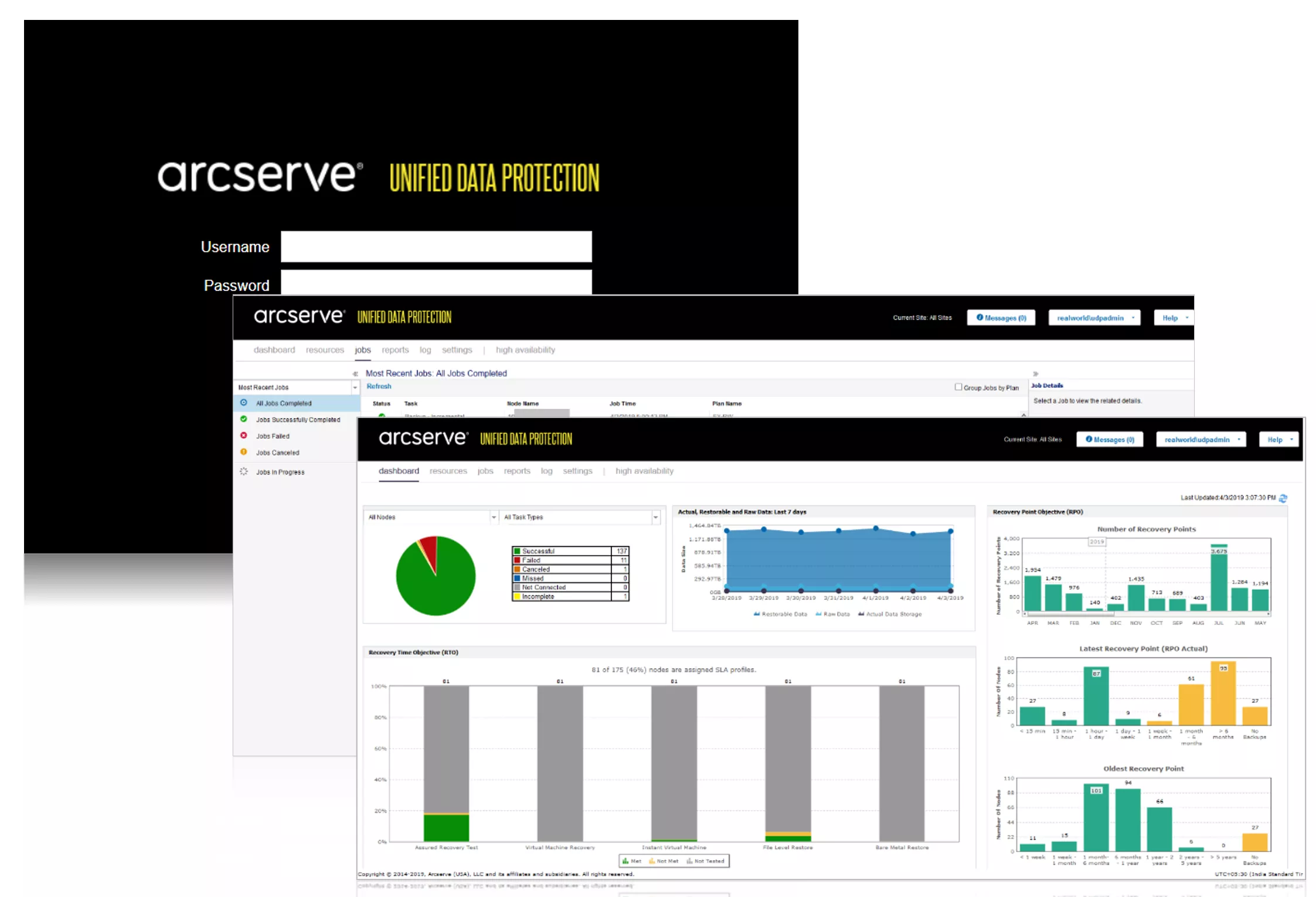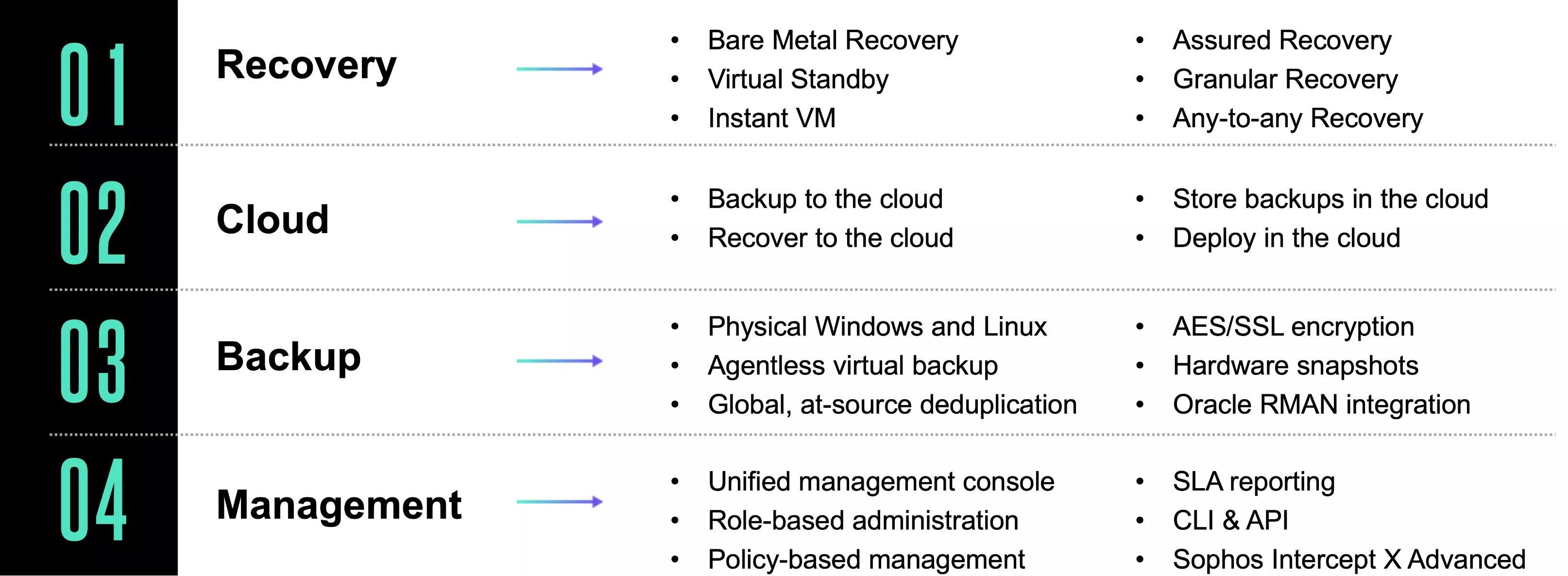Part 3 of a 3-post series
If you haven’t read the first two posts in this series (part 1, part 2) we highly recommend you do so to get a complete picture of best practices for fighting back against ransomware.
Under the Hood of Arcserve UDP: How Unified Data Protection Works
We built UDP so you get fast, simple, efficient data protection and orchestrated recovery from ransomware. But UDP has a long list of other features and benefits that further deliver on that promise.
Unified Management Console
Using a simple, single, web-services-based console, manage your entire Arcserve UDP environment—including node, group, and backup and disaster recovery plan management. Deployment, day-to-day management, and reporting are all made easier with wizards that get you started for each setup process.

Plan-Based Data Protection Policies
UDP’s unified management console manages the entire data protection lifecycle. And it uniquely gives you the capability to create intuitive, workflow-based data protection and availability strategies that form the basis for your organization’s protection and availability plans. Compare that efficiency level to traditional data protection solutions in which admins are forced to protect highly complex environments using disjointed and ever-growing lists of backup, replication, and failover policies—often across multiple products or systems.
Armed with your data protection and availability plans, the UDP unified management console makes it easy to put robust, plan-based data protection policies in place. The UDP management console also gives you detailed reporting and logs and is designed to extend your capabilities with third-party integrations.
Multi-Factor Authentication (MFA)
Arcserve UDP requires users to input multiple factors to be successfully authenticated. Microsoft and Google say that using MFA can potentially block up to 99.9 percent of automated account-hacking attacks.
Physical and Agentless Backup
Arcserve UDP makes it easy to quickly back up multiple legacy and modern workloads, including integrating agentless host-based backup for Nutanix AHV, vSphere, and Hyper-V host environments. UDP also:
- Enables single-pass backup of all VMs, without the need to install software agents
- Only backs up changed blocks, reducing traffic and storage requirements
- Ensures application-consistent backups for Exchange, SQL, Active Directory (AD), and other platforms
- Automates protection of newly added VMware and Nutanix VMs
- Makes it easy to recover individual files and folders from within each VM
Deduplication, Encryption, Compression, and Replication
UDP reduces storage consumption and network bottlenecks with source-side global deduplication, encryption, compression, and wide-area network (WAN) optimized replication. Global deduplication gives you recovery point server (RPS) capacity-optimized backups and:
- Eliminates the need for a second full backup
- Uses less disk space and network bandwidth, with a recent IT Pro review finding UDP’s global deduplication and compression to be highly efficient, taking a total of 1.9TB of data from all nodes and compressing it down to just 304GB, calling it “an impressive 84% data reduction”
- Offers enhanced cloud integration and cloud recovery in Amazon environments
- Works with software, appliance, and cloud solutions
Faster Data Restoration Options
UDP’s instant virtual machine and bare metal recovery (BMR) capabilities can restore your data faster. You also get automated local and remote virtual standby to meet your RPOs and RTOs locally or over a distance. Virtual standby converts your recovery points to virtual machine formats and prepares a snapshot that lets you easily recover your data when needed. This feature delivers high availability and ensures that the virtual machine can take over immediately when the source machine fails. Virtual standby:
- Provides application and data protection for physical servers and VMs using a periodic, image-based system
- Replicates to remotes locations such as remote offices, disaster recovery (DR) sites, managed services providers (MSPs), and the cloud
- Runs recovery point conversion into a virtual server at the remote site—in virtual hard disk (VHD), virtual machine disk file (VMDK), Nutanix AHV, or AWS EC2 formats.
- Registers with the hypervisor
- Includes server heartbeat monitoring
- Enables automated or manual failover to remote resources
The same IT Pro review cited above tested Arcserve UDP’s file and folder recovery capabilities and found that restoring the files to the host or with Exchange Online recovery was a smooth, easy process. The reviewers also say that UDP’s Instant VM feature is excellent for fast system restores through creating on-demand VMs from node recovery points. It only took the reviewers 210 seconds to use the appliance’s Hyper-V services to get a new VM up and running.
Hardware Snapshots and Backup Options
With Arcserve UDP, you can integrate hardware snapshots into your existing storage infrastructure. Switching to this backup strategy:
- Enables frequent, high-performance, low-impact, and compact snapshots of physical and virtual environments
- Stores hardware snapshot-based backups on your RPS to take advantage of global deduplication
- Tightly integrates with your host environment to ensure application-consistent backups and reliable granular restores
- Delivers a simple, fully automated snapshot orchestration process (creating, mounting, deleting, etc.)
- Supports NetApp, HPE 3PAR, and Nimble for agent-based backup in Windows physical machines and agentless backup in Hyper-V environments
- Supports Dell EM Unity for agentless backup in Hyper-V environments
- Performs fast, image-based backups to local disks and scheduled backup of recovery points to tape at local or remote sites—and even supports granular restores directly from tape
Broad Platform Support
Arcserve UDP protects your data across a long list of platforms:
- Windows
- Linux / Red Hat Enterprise Linux / CentOS /Oracle Linux Server
- File servers
- Amazon EC2
- Microsoft Azure
- Office 365 (Exchange Online, Teams, SharePoint Online, and OneDrive for Business)
- Microsoft Exchange
- MS SQL
- Microsoft IIS
- Microsoft Active Directory
- Native Oracle Database integration with RMAN
- Oracle 19c
- VMware vSphere (agentless)
- Microsoft Hyper-V (agentless)
- Debian
- Nutanix AHV
- Nutanix Files
Click here to view Arcserve UDP 8 complete software compatibility matrix.
It All Adds Up to Better Data Protection
Arcserve UDP has been recognized as a leading data protection solution because it gives you the options you need in a single, simple solution.

You don’t have to wait to see how Arcserve UDP can make a difference for your organization. Check out our no-obligation 30-day free trial or choose an expert Arcserve technology partner to help get started with unified data protection today.
You May Also Like
- Backup and Disaster Recovery Business Continuity Cloud Compliance Cybersecurity Data Protection Data Resilience Data Storage Ransomware
The Importance of Versatile Cloud Data Protection Support in a Multicloud World
December 3rd, 2024 - Backup and Disaster Recovery Business Continuity Cloud Compliance Cybersecurity Data Protection Data Resilience Ransomware
The Vital Role of Replication in Ensuring Data Resilience
November 20th, 2024 - Backup and Disaster Recovery Business Continuity Cloud Cybersecurity Data Protection Data Resilience Ransomware
Why Flexible Disaster Recovery Matters In a Hybrid World
November 12th, 2024